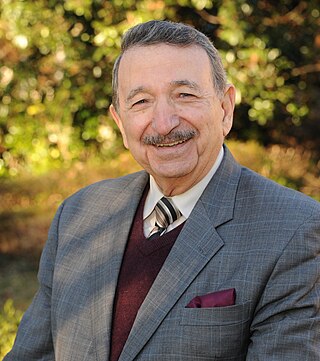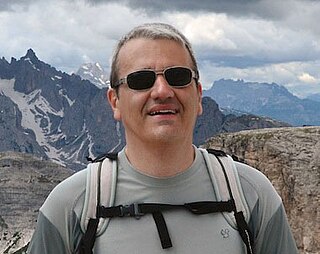
Photochemistry is the branch of chemistry concerned with the chemical effects of light. Generally, this term is used to describe a chemical reaction caused by absorption of ultraviolet, visible light (400–750 nm) or infrared radiation (750–2500 nm).

Mostafa A. El-Sayed is an Egyptian-American physical chemist, nanoscience researcher, member of the National Academy of Sciences and US National Medal of Science laureate. He is known for the spectroscopy rule named after him, the El-Sayed rule.
Minjoong Yoon is a South Korean chemist and professor.
Frans Van de Werf is a Belgian cardiologist at the University Hospital Leuven and Professor Emeritus, Department of Cardiovascular Sciences, Katholieke Universiteit Leuven. He was the chair of the university hospital's cardiovascular medicine department until 2011.

KU Leuven is a Catholic research university in the city of Leuven, Belgium.
The Journal of Photochemistry and Photobiology is a series of peer-reviewed scientific journals covering the fields of photochemistry and photobiology, published by Elsevier. It was originally established in 1972, and split into Journal of Photochemistry and Photobiology A: Chemistry and Journal of Photochemistry and Photobiology B: Biology in 1987. A third title; Journal of Photochemistry and Photobiology C: Photochemistry Reviews, was established in 2000 and is the official journal of the Japanese Photochemistry Association.

Vincenzo Balzani is an Italian chemist, now emeritus professor at the University of Bologna.
Fritz Weigert was a German physical chemist. Weigert has made major contributions in the field of photochemistry. He was born in Berlin. He was the nephew of both Karl Weigert and Paul Ehrlich. He was married to Margarete Behmer. Around 1908, he began teaching and conducting research at Berlin University - after studying there. He was a photochemistry professor at Leipzig University from 1914 until being, like other Jewish scientists, forced out by the Nazis in 1934. On January 1, 1935, he immigrated to England and in 1936 was director of the Physiochemical Department of the Cancer Research Institute at Mount Vernon Hospital, Northwood.

Nicola Armaroli is an Italian chemist, research director at the Italian National Research Council (CNR), director of the scientific magazine Sapere and member of the Italian National Academy of Sciences.
Manapurathu Verghese George was an Indian photochemist and an emeritus professor of the National Institute for Interdisciplinary Science and Technology (NIIST). He was known for establishing the Photochemistry Research Unit at NIIST and his studies on the mechanism of organic reactions. He is a recipient of the 1992 TWAS Award and an elected fellow of The World Academy of Sciences, the Indian National Science Academy and the Indian Academy of Sciences. The Council of Scientific and Industrial Research, the apex agency of the Government of India for scientific research, awarded him the Shanti Swarup Bhatnagar Prize for Science and Technology, one of the highest Indian science awards, in 1973, for his contributions to chemical sciences.
Alexander von Zelewsky was a full Professor in chemistry at the University of Fribourg in Fribourg, Switzerland, from 1969 to 2006.
Christopher Barner-Kowollik FAA, FQA, FRSC, FRACI is an Australian Research Council (ARC) Laureate Fellow, the Senior Deputy Vice-Chancellor and Vice-President (Research) of the Queensland University of Technology (QUT) and Distinguished Professor within the School of Chemistry and Physics at the Queensland University of Technology (QUT) in Brisbane. He is the Editor-in-Chief of the Royal Society of Chemistry (RSC) journal Polymer Chemistry, a principal investigator within the Soft Matter Materials Laboratory at QUT and associate research group leader at the Karlsruhe Institute of Technology (KIT).
Rachel Claire EvansFLSW is a Welsh chemist based at the University of Cambridge and a fellow of Jesus College, Cambridge. She works on photoactive polymer-hybrid materials for solar devices, including organic photovoltaics and stimuli-responsive membranes.
Johan Hendrik Neyts is a Belgian virologist. He is head of The Neyts-lab of Virology, Antiviral Drug and Vaccine Research, which is part of the Laboratory of Virology and Chemotherapy at the Rega Institute for Medical Research, and full professor of virology at the Faculty of Medicine of KU Leuven. During the 2019-2020 coronavirus pandemic, Neyts came to national prominence as an expert on the (re)search for antiviral drugs and vaccines against SARS-CoV-2.
John Philip Simons is a British physical chemist known for his research in photochemistry and photophysics, molecular reaction dynamics and the spectroscopy of biological molecules. He was professor of physical chemistry at the University of Nottingham (1981–93) and Dr. Lee's Professor of Chemistry at the University of Oxford (1993–99).
Yvan J. Bruynseraede is a condensed matter experimental physicist, known for his work on multilayers and superlattices, and his interests are thin films, nanostructures, novel materials, magnetism, and superconductivity. He is currently Professor Emeritus at the Catholic University of Leuven (KULeuven), and a member of the Quantum Solid-State Physics Laboratory.
Linda A. Peteanu is an American chemist who is a professor and head of the department of chemistry at Carnegie Mellon University. Her research considers the steady state and transient photophysics of conjugated molecules.
Photochemical action plots are a scientific tool used to understand the effects of different wavelengths of light on photochemical reactions. The methodology involves exposing a reaction solution to the same number of photons at varying monochromatic wavelengths, monitoring the conversion or reaction yield of starting materials and/or reaction products. Such global high-resolution analysis of wavelength-dependent chemical reactivity has revealed that maxima in absorbance and reactivity often do not align. Photochemical action plots are historically connected to (biological) action spectra.





